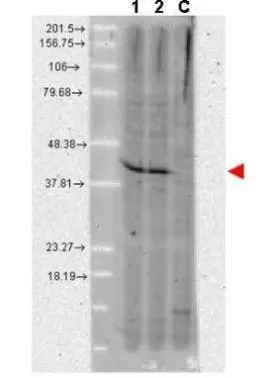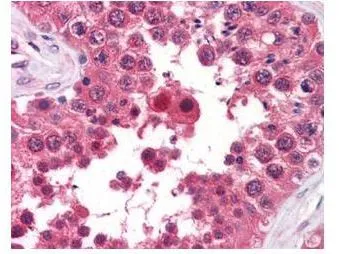
Western blot using GeneTexs anti-AHA1 monoclonal antibody shows detection of a band ~42 kDa in size corresponding to AHA1 in A431 whole cell lysate (lane 1) and MCF-7 whole cell lysate (lane 2). A control lane is shown where primary ahntibody was omitted from the incubation (lane C). Molecular weight markers are shown at the left. For best results, block the membrane overnight with 3% BSA in TBS followed by reaction with primary antibody diluted 1:1,000 and use HRP conjugated anti-Rabbit IgG secondary antibody diluted 1:20,000 in blocking buffer) for detection.
AHA-1 antibody [25F2.D9]
GTX48775
ApplicationsWestern Blot, ELISA, ImmunoHistoChemistry, ImmunoHistoChemistry Paraffin
Product group Antibodies
TargetAhsa1
Overview
- SupplierGeneTex
- Product NameAHA-1 Antibody [25F2.D9]
- Delivery Days Customer9
- Application Supplier NoteWB: 1:1000. IHC-P: 5-10 microg/mL. ELISA: 1:20000. *Optimal dilutions/concentrations should be determined by the researcher.Not tested in other applications.
- ApplicationsWestern Blot, ELISA, ImmunoHistoChemistry, ImmunoHistoChemistry Paraffin
- CertificationResearch Use Only
- ClonalityMonoclonal
- Clone ID25F2.D9
- Concentration1 mg/ml
- ConjugateUnconjugated
- Gene ID217737
- Target nameAhsa1
- Target descriptionAHA1, activator of heat shock protein ATPase 1
- Target synonymsp38, activator of 90 kDa heat shock protein ATPase homolog 1, AHA1, activator of heat shock 90kDa protein ATPase homolog 1, AHA1, activator of heat shock protein ATPase homolog 1
- HostRat
- IsotypeIgG2a
- Protein IDQ8BK64
- Protein NameActivator of 90 kDa heat shock protein ATPase homolog 1
- Scientific DescriptionActivator of Hsp90 ATPase (AHA1) stimulates the inherent ATPase cycle of Hsp90, which is essential for its chaperone activity in vivo. The activation and/or stability of many of the key regulatory and signaling proteins of the eukaryotic cell depend on their interaction with the Hsp90 molecular chaperone. Hsp90 is assisted and regulated by co-chaperones that participate in an ordered series both to assist client-protein recruitment or release and to modulate progress through the ATPase coupled chaperone cycle. Structural analysis and mutagenesis show that binding of the N-terminal domain of AHA1 to Hsp90 promotes a conformational switch in the middle-segment catalytic loop (aa 370-390) of Hsp90 that exposes the catalytic Arg380 and enables its interaction with ATP in the N-terminal nucleotide-binding domain of the chaperone. Recent studies show that AHA1 modulates Hsp90-dependent stability of the folding of the cystic fibrosis transmembrane conductance regulator (CFTR) in the endoplasmic reticulum (ER). Down-regulation of AHA1 rescues misfolding of CFTR in cystic fibrosis.
- Storage Instruction-20°C or -80°C,2°C to 8°C
- UNSPSC12352203


![WB analysis of various samples using GTX48775 AHA-1 antibody [25F2.D9]. Lane 1 : A431 whole cell lysate Lane 2 : MCF-7 whole cell lysate Lane C : Without primary antibody Dilution : 1:1000 WB analysis of various samples using GTX48775 AHA-1 antibody [25F2.D9]. Lane 1 : A431 whole cell lysate Lane 2 : MCF-7 whole cell lysate Lane C : Without primary antibody Dilution : 1:1000](https://www.genetex.com/upload/website/prouct_img/normal/GTX48775/GTX48775_20240423_WB_302_24042320_368.webp)